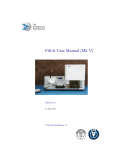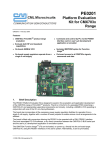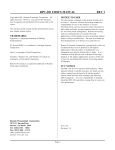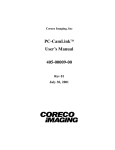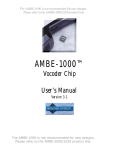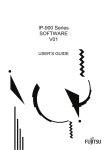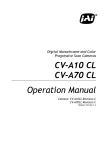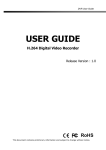Download CV-A10GE Manual
Transcript
Digital Monochrome/Color Progressive Scan GigE Vision Camera CV-A10 GE CV-A70 GE Operation Manual Hardware part Camera Revision: 0 Manual revision: 1.0 CV-A10 GE / CV-A70 GE Table of Contents 1. General......................................................................................................... 3 2. Standard Composition ....................................................................................... 3 3. Main Features ................................................................................................. 4 4. Locations and Functions..................................................................................... 5 5. Pin Assignment................................................................................................ 6 5.1. 12-pin Multi-connector (DC-in/GPIO/Iris Video) ............................................................. 6 5.2. Digital Output Connector for Gigabit Ethernet............................................................... 6 6. GPIO (Inputs and outputs ) ................................................................................. 7 6.1. Overview .......................................................................................................... 7 6.1.1. LUT ( Look Up Table) ..................................................................................... 7 6.1.2. 12-bit Counter ............................................................................................. 7 6.1.3. Pulse Generators .......................................................................................... 7 6.2. Inputs and outputs table ........................................................................................ 8 6.2.1. Equivalent circuit for TTL 1, 2 and 3 inputs .......................................................... 9 6.2.2. Equivalent circuit for LVDS input ....................................................................... 9 6.2.4. Equivalent circuit for TTL 1 and 2 outputs........................................................... 9 6.3. Configuring the GPIO module (register settings) ...........................................................10 6.3.1. Input/Output Signal Selector...........................................................................10 6.3.2. xTTL_LVDS Selector......................................................................................10 6.3.3. 12-bit counter ............................................................................................10 6.3.4. Pulse generators (20 bit x 4) ...........................................................................10 6.4 GPIO programming examples ...................................................................................12 6.4.1 Trigger Phase Control .....................................................................................12 6.4.3 Multi EEN Control with PWC..............................................................................14 7. GigE Vision Streaming Protocol (GVSP) ................................................................ 15 7.1. Digital Video Output (Bit Allocation).........................................................................15 7.2. Bit Allocation (Pixel Format / Pixel Type) – CV-A10GE....................................................15 7.2.1. GVSP_PIX_MONO8 (8bit) ................................................................................15 7.2.2. GVSP_PIX_MONO10 (10bit).............................................................................15 7.3. Bit Allocation (Pixel Format / Pixel Type) – CV-A70GE....................................................16 7.3.1 GVSP_PIX_BAYGB8 “BayerGB8” ( For Full and 1/8 partial scanning ) ...........................16 7.3.2 GVSP_PIX_BAYGB10 “ BayerGB10” ( For Full and 1/8 partial scanning ).........................16 7.3.3 GVSP_PIX_BAYRG8 “ BayerRG8 “ ( For 1/2 and 1/4 partial scanning ) .........................16 7.3.4 GVSP_PIX_BAYRG10 “Bayer RG10” ( For 1/2 and 1/4 partial scanning ) .........................16 8. Functions and Operations ................................................................................. 17 8.1. GigE Vision Standard Interface ................................................................................17 8.2. Recommended Network Configurations ......................................................................17 8.2.1 Verified Network Interface Cards (NICs) ...............................................................17 8.2.2 Video data rate (network bandwidth) ..................................................................17 8.3. Basic functions ...................................................................................................18 8.3.1 Vertical Binning (CV-A10 GE only). ..................................................................18 8.3.2 CV-A70 CL. Bayer filter ..................................................................................19 8.3.3 Electronic Shutter.........................................................................................19 8.3.4. ROI ( Region of Interest ) ...............................................................................20 8.3.5 Auto Iris Lens video output (12-pin Hirose connector) ..............................................21 8.3.5 Auto Iris Lens video output (12-pin Hirose connector) ..............................................21 8.4. Sensor Layout and timing ......................................................................................22 8.4.1. CCD Sensor Layout ........................................................................................22 8.4.2. Horizontal timing .........................................................................................23 8.4.3. Vertical timing ............................................................................................23 8.4.4. Partial Scanning ...........................................................................................24 8.4.5. Vertical binning ...........................................................................................24 8.5. Operation Modes .................................................................................................25 8.5.1. LVAL synchronous accumulation .......................................................................26 8.5.2. LVAL a-synchronous accumulation ....................................................................27 8.5.3. Continuous operation....................................................................................28 8.5.4. Edge Pre-select Trigger Mode ..........................................................................29 8.5.5. Pulse Width Control Trigger Mode.....................................................................30 -1- CV-A10 GE / CV-A70 GE 8.5.6. Sequencer Trigger Mode ( EPS) ........................................................................31 8.5.7. Delayed Readout Mode (EPS, PWC) ...................................................................32 8.6. Operation Mode and Functions matrix .......................................................................33 9. Register Map ................................................................................................ 34 10. External Appearance and Dimensions ................................................................. 41 11. Specifications.............................................................................................. 41 11.1. Spectral response...............................................................................................41 11.2. Specification table .............................................................................................42 12. Appendix................................................................................................... 43 12.1. Precautions .....................................................................................................43 12.2. Typical Sensor Characteristics ...............................................................................43 12.3. References ......................................................................................................44 Index.....................................................................................................................45 12. User's Record ................................................................................................ 1 -2- CV-A10 GE / CV-A70 GE 1. General This manual covers the digital monochrome progressive scan camera CV-A10 GE and color progressive scan camera CV-A70 GE The CV-A10GE/CV-A70GE is a GigE Vision compliant camera, based on the CV-A10CL/CV-A70CL. Both the monochrome version CV-A10GE and the color version CV-A70GE provide a frame rate of 60 frames/second at full resolution. Using vertical binning (CV-A10GE only) and partial scan provides higher frame rates. The 1/2" CCD with square pixels offers a superb image quality. The high-speed shutter function and asynchronous random trigger mode allows the camera to capture high quality images of fast moving objects. The color version CV-A70 GE, based on CCD sensor with primary RGB Bayer mosaic filter, outputs raw Bayer images. Host-based color interpolation is required to display or save color images. The CV-A10GE/CV-A70GE also complies with the GenICam standards, as it has in internal XML file that is used to describe the functions/features of the camera. For further information on GenICam please go to www.emva.org. As an application programming interface, JAI provides an SDK (Software Development Kit). This SDK includes software documentation, register information, code examples and objects such as Transport Layer and Device Drivers (Optimized Filter Driver and Standard Windows Stack). The JAI SDK Light can be downloaded from www.jai.com The latest version of this manual can be downloaded from www.jai.com For camera revision history, please contact your local JAI distributor. 2. Standard Composition The standard camera composition consists of the camera main body and C-mount protection cap. The camera is available in the following versions: CV-A10 GE - Monochrome progressive CCD scan camera. CV-A70 GE - Raw Bayer color progressive CCD scan camera. -3- CV-A10 GE / CV-A70 GE 3. Main Features • • • • • • • • • • • • • 1/2” progressive scan camera Monochrome and Bayer color versions 782 (h) x 582 (v) 8.37µm square pixels 60 fps with full resolution 250 fps with 1/8 partial scan Vertical binning (CV-A10GE) for higher frame rates and sensitivity High speed shutter from 1/60 to 1/300,000 second 8 or 10-bit output Edge pre-select, and pulse width trigger modes Auto shutter and smear-less mode Auto-Iris lens video output, auto shutter and AGC allow a wider light range Programmable GPIO module Comprehensive software suite and SDK ( SDK Light ) for Windows XP -4- CV-A10 GE / CV-A70 GE 4. Locations and Functions ⑧ ⑤ ④ HIROSE 12p i n Conne ctor POW ER / TRI G ② D C IN / T RI G ⑥ Gig E LIN K ACT. ⑦ 1 2 3 4 5 6 7 8 ③ Ser i al No. FCC seal ① Lens mount of C-mount type. *1) Interline-transfer CCD sensor. GigE connector ( RJ-45 ) 12-pin connector for DC +12V power and GPIO interface LED for power and trigger indication LED for GigE Network status : LINK LED for GigE Network status : ACT. Mounting holes 8 x M3 (depth 4 mm) *1) Note: Rear protrusion on C-mount lens must be less than 9.0mm. When IR cut filter is used, it must be less than 6.0 mm. The IR cut filter is placed in the C-mount thread. The C-mount 25 mm IR cut filter must be ordered separately. Fig. 1. Locations -5- GigE conne ctor ( RJ- 45) CV-A10 GE / CV-A70 GE 5. Pin Assignment 5.1. 12-pin Multi-connector (DC-in/GPIO/Iris Video) Type: HR10A-10R-12PB (Hirose) male. (Seen from rear of camera.) 9 1 2 11 3 4 8 10 7 12 5 6 Pin no. 1 2 3 4 5 6 7 8 9 10 11 12 Signal GND +12 V DC input GND Iris video GND LVDS+/TTL IN 1 LVDS-/TTL IN 2 TTL OUT 1 TTL OUT 2 TTL IN 3 NC GND Remarks Only Continuous mode. GPIO IN / OUT Fig. 2. 12-pin connector. 5.2. Digital Output Connector for Gigabit Ethernet Type: RJ-45 8 7 6 54 3 2 1 Fig. 3. Gigabit Ethernet connector The digital output signals follow the Gigabit Ethernet interface using RJ-45 conforming connector. The following is pin assignment for Gigabit Ethernet connector. Pin No 1 2 3 4 5 6 7 8 In/Out In/Out In/Out In/Out In/Out In/Out In/Out In/Out In/Out Name MX1+ (DA+) MX1- (DA-) MX2+ (DB+) MX3+ (DC+) MX3- (DC-) MX2- (DB-) MX4+ (DD+) MX4- (DD-) -6- CV-A10 GE / CV-A70 GE 6. GPIO (Inputs and outputs ) 6.1. Overview All input and output signals pass through the GPIO (General Purpose Input and Output) module. The GPIO module consists of a Look-Up Table (LUT – Cross-Point Switch), 4 Pulse Generators and a 12-bit counter. In the LUT, the relationship between inputs, counters and outputs is governed by internal register set-up. LVAL IN DVAL IN FVAL IN EEN IN HIROSE TTL IN 1 HIROSE TTL IN 2 LVDS IN xTTL_LVDS LUT Sel CAMERA TRIGGER CAMERA Ext. VD C CAMERA Ext. HD HIROSE TTL OUT 1 HIROSE TTL OUT 2 (Cross point switch) HIROSE TTL IN 3 Soft Trigger 0 Pulse Generator 3 (20bit Counter) Pulse Generator 2 (20bit Counter) Pulse Generator 1 (20bit Counter) Pulse Generator 0 (20bit Counter) 25MHz Pixel Clock 12bit Counter The blocks shown in the above diagram have the following functionality: 6.1.1. LUT ( Look Up Table) The LUT works as a cross-point switch which allows connecting inputs and outputs freely. The signals LVAL_IN, DVAL_IN, FVAL_IN and EEN_IN all originate from the camera timing circuit. The signal CAMERA_TRIGGER is connected to the camera timing circuit, allowing a hardware trigger. LUT works as a cross point switch which connects inputs and outputs freely. 6.1.2. 12-bit Counter A 25MHz clock or the camera pixel clock can be used as a source. The counter has a “Divide by N”, where N has the range 1 through 4096, allowing a wide range of clock frequencies to be programmed. 6.1.3. Pulse Generators (0 to 3) Each pulse generator consists of a 20-bit counter. The behavior of these signals is defined by their pulse width, start point, end point and number of repetitions. The pulse generator signals can be set in either triggered or periodic mode. In triggered mode, the pulse is triggered by the rising edge/falling edge/high level or low level of the input signal. In periodic mode, the trigger continuously generates a signal that is based on the configured pulse width, starting point, end point and repetitions. -7- CV-A10 GE / CV-A70 GE 6.2. Inputs and outputs table Signals LVAL_IN I/O I DVAL IN FVAL_IN EEN_IN HIROSE_TTL_IN1 I I I I HIROSE_TTL_IN2 I LVDS_IN I HIROSE_TTL_IN3 I Soft_Trigger_0 I Pulse Generator out Pulse Generator out Pulse Generator out Pulse Generator out CAMERA TRIGGER HIROSE TTL OUT 1 HIROSE TTL OUT 2 Pulse Pulse Pulse Pulse Generator Generator Generator Generator in in in in 0 1 2 3 I I I I O O O 0 1 2 3 O O O O description LVAL from camera DVAL from camera FVAL from camera EEN from camera TTL-input from Hirose pin 6 Active when TTL is selected by xTTL_LVDS Sel TTL-input from Hirose pin 7 Active when TTL is selected by xTTL_LVDS Sel Hirose connector Pin 6: LVDS + Pin 7: LVDS – Active when LVDS is selected by xTTL_LVDS Sel TTL input signal from Hirose connector pin 10 Software trigger input from Ethernet Pulse Generator 0 output Pulse Generator 1 output Pulse Generator 2 output Pulse Generator 3 output Trigger signal to camera TTL output to Hirose connector pin 8 TTL output to Hirose connector pin 9 Pulse Generator 0 Clear input Pulse Generator 1 Clear input Pulse Generator 2 Clear input Pulse Generator 3 Clear input -8- diagram Fig. 4 Fig. 4 Fig. 5 Fig. 4 Fig. 6 Fig. 6 CV-A10 GE / CV-A70 GE 6.2.1. Equivalent circuit for TTL 1, 2 and 3 inputs TTL_IN 1,2 and 3 R614 47kB R618 2k2B This circuit is for TTL IN 1, TTL IN 2 and TTL IN 3 through pins 6, 7 and 10 (respectively) at the 12-pin Hirose connector. It is a DC coupled input. See GPIO selector for setting this input (TTL or LVDS). R617 2k2B 8 R619 10kB 3 1 4 U604A 33kB R616 2 AD8062AR Fig.4 Hirose TTL IN (1 and 2) equivalent circuit 6.2.2. Equivalent circuit for LVDS input This circuit is for LVDS IN – and + through pins 6 and 7 the 12-pin Hirose connector. See GPIO selector for setting this input (TTL or LVDS). LVDS_IN+ D1 R1 100 + U1A - LVDS_IN- D2 Fig.5 LVDS IN equivalent circuit 6.2.4. Equivalent circuit for TTL 1 and 2 outputs This circuit is for TTL OUT 1 and 2 through pins 8 and 9 of the Hirose 12-pin connector. The output is sent from 75 ohm source which is a complementary Emitter-follower circuit. The supply voltage for this circuit is 5V. 3 +5V 5 4 Q1B R1 10 R3 120 TTL_OUT1 R4 150 1 R2 10 2 Fig.6 6 Q1A -9- Hirose TTL OUT equivalent circuit CV-A10 GE / CV-A70 GE 6.3. Configuring the GPIO module (register settings) 6.3.1. Input/Output Signal Selector Address Internal Name Access Size 0xB058 CAMERA TRIGGER Selector R/W 4 0xB05C CAMERA Ex. VD Selector R/W 4 0xB060 CAMERA Ex. HD Selector R/W 4 0xB064 HIROSE TTL OUT 1 Selector R/W 4 0xB068 HIROSE TTL OUT 2 Selector R/W 4 0xB06C Pulse Generator 0 Selector R/W 4 0xB070 Pulse Generator 1 Selector R/W 4 0xB074 Pulse Generator 2 Selector R/W 4 0xB078 Pulse Generator 3 Selector R/W 4 Value (Range) GPIO Selector: 0x00:CAMERA LVAL IN 0x01:CAMERA DVAL IN 0x02:CAMERA FVAL IN 0x03:CAMERA EEN IN 0x04:HIROSE TTL IN 1 0x05:HIROSE TTL IN 2 0x06:HIROSE TTL IN 3 0x07:HIROSE LVDS IN 0x09:SOFT TRIG 0 0x0D:Pulse Generator 0 0x0E:Pulse Generator 1 0x0F:Pulse Generator 2 0x10:Pulse Generator 3 0x7F:No Connect (default) Add 0x80 will result in low active output. 6.3.2. xTTL_LVDS Selector Address 0xA8B0 Internal Name xTTL_LVDS Select Access Size R/W 4 Info or Assign 0x00 : TTL In 1 and TTL In 2 Active 0x01 : LVDS In Active 6.3.3. 12-bit counter Address Internal Name Access Size 0xB000 Clock source R/W 4 0xB004 Divide by N R/W 4 Value (Range) 0x00: 25MHz 0x01: Pixel Clock 0x000: N=1 0x001: N=2 0x002: N=3 | 0xFFF: N=4096 6.3.4. Pulse generators (20 bit x 4) There are 4 pulse generators (designated 0 through 3) that can be used to create various timing scenarios by programming start point, endpoint, length and repeats. Start Point End Point Length - 10 - CV-A10 GE / CV-A70 GE Address 0xB008 0xB00C Internal Name Length Counter 0 Start point Counter 0 Access R/W R/W Size 4 4 0xB010 Repeat Count 0 R/W 4 0xB014 End point Counter 0 R/W 4 0xB018 Counter Clear 0 R/W 4 0xB01C 0xB020 Length Counter 1 Start point Counter 1 R/W R/W 4 4 0xB024 Repeat Count 1 R/W 4 0xB028 End point Counter 1 R/W 4 0xB02C Counter Clear 1 R/W 4 0xB030 0xB034 Length Counter 2 Start point Counter 2 R/W R/W 4 4 0xB038 Repeat Count 2 R/W 4 0xB03C End point Counter 2 R/W 4 0xB040 Counter Clear 2 R/W 4 0xB044 0xB048 Length Counter 3 Start point Counter 3 R/W R/W 4 4 0xB04C Repeat Count 3 R/W 4 0xB050 End point Counter 3 R/W 4 0xB054 Counter Clear 3 R/W 4 - 11 - Value (range) 0x00001 to 0xFFFFF 0x00000 to 0xFFFFF 0x00: infinite 0x01: 1 time | 0xFF: 255 times 0x00001 to 0xFFFFF 0: Free Run 1: High Level Clear 2: Low Level Clear 4: Rising Edge Clear 8: Falling Edge Clear 0x00001 to 0xFFFFF 0x00000 to 0xFFFFF 0: Infinite 1: 1 time | 255: 255 times 0x00001 to 0xFFFFF 0x00: Free Run 0x01: High Level Clear 0x02: Low Level Clear 0x04: Rising Edge Clear 0x08: Falling Edge Clear 0x00001 to 0xFFFFF 0x00000 to 0xFFFFF 0x00: Infinite 0x01: 1 time | 0xFF: 255 times 0x00001 to 0xFFFFF 0x00: Free Run 0x01: High Level Clear 0x02: Low Level Clear 0x04: Rising Edge Clear 0x08: Falling Edge Clear 0x00001 to 0xFFFFF 0x00000 to 0xFFFFF 0x00: Infinite 0x01: 1 time | 0xFF: 255 times 0x00001 to 0xFFFFF 0x00: Free Run 0x01: High Level Clear 0x02: Low Level Clear 0x04: Rising Edge Clear 0x08: Falling Edge Clear CV-A10 GE / CV-A70 GE 6.4 GPIO programming examples 6.4.1 Trigger Phase Control 100 clock delay to the input Trigger Address Register 0xA040 Trigger Mode 0xB000 Clock Choice 0xB004 Counter Dividing Value 0xB008 Length Counter 0 0xB00C Start point Counter 0 0xB010 Repeat Count 0 0xB014 End point Counter 0 0xB018 Counter Clear 0 0xB058 CAMERA TRIGGER Selector 0xB06C Pulse Generator 0 Selector LVAL IN DVAL IN FVAL IN EEN IN HIROSE TTL IN 1 HIROSE TTL IN 2 LVDS IN xTTL_LVDS Select CAMERA TRIGGER CAMERA Ext. VD CAMERA Ext. HD HIROSE TTL OUT 1 HIROSE TTL OUT 2 LUT ( Cross point switch) HIROSE TTL IN 3 Soft Trigger 0 Pulse Generator 3 (20bit Counter) Pulse Generator 2 (20bit Counter) Pulse Generator 1 (20bit Counter) Pulse Generator 0 (20bit Counter) 25MHz Pixel Clock 12bit Counter HIROSE TTL IN 1 Pulse Generator 0 output 100 500 1000 - 12 - Value 1 = EPS(Edge pre-select) 1 = Pixel Clock 0 = Pass through 1000 Clocks 100 Clocks 1 500 Clocks 4 = Rising Edge Clear 13 = pulse generator 0 4 = HIROSE TTL In 1 CV-A10 GE / CV-A70 GE 6.4.2 Internal Trigger Generator Create a trigger signal and trigger the camera Address Register 0xA040 Trigger Mode 0xB000 Clock Choice 0xB004 Counter Dividing Value 0xB008 Length Counter 0 0xB00C Start point Counter 0 0xB010 Repeat Count 0 0xB014 End point Counter 0 0xB018 Counter Clear 0 0xB058 CAMERA TRIGGER Selector LVAL IN DVAL IN FVAL IN EEN IN HIROSE TTL IN 1 HIROSE TTL IN 2 LVDS IN LUT ( Cross point switch) xTTL_LVDS Select HIROSE TTL IN 3 Soft Trigger 0 Pulse Generator 3 (20bit Counter) Pulse Generator 2 (20bit Counter) Pulse Generator 1 (20bit Counter) Pulse Generator 0 (20bit Counter) 25MHz Pixel Clock 12bit Counter Line Rate 37.5KHz Pulse Generator 0 output 100 Line 500 Line 1000 Line Pulse Generator 0 timing - 13 - Value 1 = EPS 1 = Pixel Clock 963 = 1/964 dev(Line Rate) 1000 Clocks 100 Clocks 0 = Free Run 500 Clocks 0 = No Clear 13 = pulse generator 0 CAMERA TRIGGER CAMERA Ext. VD CAMERA Ext. HD HIROSE TTL OUT 1 HIROSE TTL OUT 2 CV-A10 GE / CV-A70 GE 6.4.3 Multi EEN Control with PWC Camera EEN converts to 3 pulses and feed camera in PWC mode Address 0xA040 0xB000 0xB004 0xB008 0xB00C 0xB010 0xB014 0xB018 0xB058 0xB06C Register Trigger Mode Clock Choice Counter Dividing Value Length Counter 0 Start point Counter 0 Repeat Count 0 End point Counter 0 Counter Clear 0 CAMERA TRIGGER Selector Pulse Generator 0 Selector LVAL IN DVAL IN FVAL IN EEN IN HIROSE TTL IN 1 HIROSE TTL IN 2 LVDS IN Value 2 = PWC(Pulse width control) 1 = Pixel Clock 963 = 1/964dev(Line Rate) 1000 Clocks 100 Clocks 3 Cycles 500 Clocks 1 = Level Low 4 = Hirose TTL IN 1 3 = CAMERA EEN IN LUT ( Cross point switch) xTTL_LVDS Select HIROSE TTL IN 3 Soft Trigger 0 Pulse Generator 3 (20bit Counter) Pulse Generator 2 (20bit Counter) Pulse Generator 1 (20bit Counter) Pulse Generator 0 (20bit Counter) 25MHz Pixel Clock 12bit Counter Line Rate 37.5KHz EEN IN output 500 1000 Pulse Generator 0 timing - 14 - CAMERA TRIGGER CAMERA Ext. VD CAMERA Ext. HD HIROSE TTL OUT 1 HIROSE TTL OUT 2 CV-A10 GE / CV-A70 GE 7. GigE Vision Streaming Protocol (GVSP) 7.1. Digital Video Output (Bit Allocation) Although the CV-A10GE and CV-A70GE are digital cameras, the image is generated by an analog component, the CCD sensor. The table and diagram below show the relationship between the analog CCD output level and the digital output. CCD out Black 200mV 230mV Analog Signal * Setup 3.6%, 25mV 700mV 800mV Digital Out(8-bit) 32LSB 890LSB 1023LSB Digital Out(10-bit) 8LSB 222LSB 255LSB The standard setting for 10-bit video level is 890 LSB. For 8-bit, the standard setting is 222 LSB. 200 mV CCD output level, 100% video output. 1023 Wh i te C l ip Leve l 890 D ig i ta l Ou t [LSB ] 100 % Leve l 32 B lack Leve l 0 25 Ana log S igna l m [ V] 700 800 Fig.7. Analog to Digital conversion 7.2. Bit Allocation (Pixel Format / Pixel Type) – CV-A10GE In the GigE Vision Interface, GVSP(GigE Vision Streaming Protocol) is used for an application layer protocol relying on the UDP transport layer protocol. It allows an application to receive image data, image information and other information from a device. In CV-A10GE, the following pixel types supported by GVSP are available. With regard to the details of GVSP, please refer GigE Vision Specification available from AIA (www.machinevisiononline.org). 7.2.1. GVSP_PIX_MONO8 (8bit) 1Byte 2Byte 3Byte Y0 Y1 Y2 0 1 2 3 4 5 6 7 0 1 2 3 4 5 6 7 0 1 2 3 4 5 6 7 7.2.2. GVSP_PIX_MONO10 (10bit) 1Byte 2Byte 3Byte 4Byte Y0 Y0 Y1 Y1 0 1 2 3 4 5 6 7 8 9 X X X X X X 0 1 2 3 4 5 6 7 8 9 X X X X X X Address 0xA410 Internal Name Pixel Format type Access Size R/W 4 - 15 - Value 0x01080001:Mono8 0x01100003:Mono10 CV-A10 GE / CV-A70 GE 7.3. Bit Allocation (Pixel Format / Pixel Type) – CV-A70GE In the GigE Vision Interface, GVSP(GigE Vision Streaming Protocol) is used for an application layer protocol relying on the UDP transport layer protocol. It allows an application to receive image data, image information and other information from a device. In CV-A70GE, the following pixel types supported by GVSP are available. With regard to the details of GVSP, please refer GigE Vision Specification available from AIA. 7.3.1 GVSP_PIX_BAYGB8 “BayerGB8” ( For Full and 1/8 partial scanning ) Odd Line G0 B1 G2 0 1 2 3 4 5 6 7 0 1 2 3 4 5 6 7 0 1 2 3 4 5 6 7 Even Line R0 G1 R2 0 1 2 3 4 5 6 7 0 1 2 3 4 5 6 7 0 1 2 3 4 5 6 7 7.3.2 GVSP_PIX_BAYGB10 “ BayerGB10” ( For Full and 1/8 partial scanning ) Odd Line 1 Byte 2 Byte 3 Byte 4 Byte G0 G0 B1 B1 0 1 2 3 4 5 6 7 8 9 X X X X X X 0 1 2 3 4 5 6 7 8 9 X X X X X X Even Line R0 R0 G1 G1 0 1 2 3 4 5 6 7 8 9 X X X X X X 0 1 2 3 4 5 6 7 8 9 X X X X X X 7.3.3 GVSP_PIX_BAYRG8 “ BayerRG8 “ ( For 1/2 and 1/4 partial scanning ) Odd Line 1 Byte 2 Byte 3 Byte R0 G1 R2 0 1 2 3 4 5 6 7 0 1 2 3 4 5 6 7 0 1 2 3 4 5 6 7 Even Line G0 B1 G2 0 1 2 3 4 5 6 7 0 1 2 3 4 5 6 7 0 1 2 3 4 5 6 7 7.3.4 GVSP_PIX_BAYRG10 “Bayer RG10” ( For 1/2 and 1/4 partial scanning ) Odd Line 1 Byte 2 Byte 3 Byte 4 Byte R0 R0 G1 G1 0 1 2 3 4 5 6 7 8 9 X X X X X X 0 1 2 3 4 5 6 7 8 9 X X X X X X Even Line G0 G0 B1 B1 0 1 2 3 4 5 6 7 8 9 X X X X X X 0 1 2 3 4 5 6 7 8 9 X X X X X X Address 0xA410 Internal Name Pixel Format type Access Size R/W 4 - 16 - Value 0x01080009:BAYRG8 0x0108000A:BAYGB8 0x0110000D:BAYRG10 0x0110000E:BAYGB10 CV-A10 GE / CV-A70 GE 8. Functions and Operations 8.1. GigE Vision Standard Interface The CV-A10GE and CV-A70GE are designed in accordance with the GigE Vision standard. In transmits digital images over Cat5e or Cat6 Ethernet cables. All camera functions are also controlled via the GigE Vision interface. The camera can operate in continuous mode, providing an endless stream of images. For capturing individual images, related to a specific event, the camera can also be trigged. For precise triggering, it is recommended to use a hardware trigger applied to the Hirose 12-pin connector. It is also possible to initiate a software trigger through the GigE Vision interface. However, when using software trigger, certain latency inherent to the GigE interface must be anticipated. This latency, that manifests itself as jitter, greatly depends on the general conditions and traffic on the GigE connection. The frame rate described in this manual is for the ideal case and may deteriorate depending on conditions. When using multiple cameras (going through a switch and/or a single path) or when operating in a system with limited transmission bandwidth the Delayed Readout Mode and Inter-Packet Delay functions can be useful. Details on how to use these functions are described in the SDK documentation. 8.2. Recommended Network Configurations Although the CV-A10GE / CV-A70GE conforms to Gigabit Ethernet (IEEE 802.3) not all combinations of network interface cards (NICs) and Switches/Routers are suitable for use with the GigE Vision compliant camera. JAI will endeavor to continuously verify these combinations, in order to give users the widest choice of GigE components for their system design. 8.2.1 Verified Network Interface Cards (NICs) At the time of publishing this document these combinations have been verified: NIC manufacturer Intel Intel Intel Model PRO/1000MT (PWLA8490MT) PRO/1000GT (PWLA8391GT) PRO/1000PT (EXPI9300PT) PCI Bus PCI-X Bus PCI-Express Bus √ (33MHz) √(100MHz) − √ (33MHz) √ (33MHz) − − − √ ( x1 ) Minimum PC requirements are as follows in order to fulfill the above conditions: IntelP4 2.8G (HT) or better, alternatively AMD Athlon 64 x2, CPU At least 1 GB memory More than 200 GB free disk space Windows XP, SP2 (32bit) Optimized filter driver included in the JAI SDK Light. 8.2.2 Video data rate (network bandwidth) The video bit rate for CV-A10GE / CV-A70GE is: 8 bit pixel format (GVSP_PIX_MONO8/Bayer8) 10 bit pixel format (GVSP_PIX_MONO10/Bayre10) - 17 - 212 M bit/s [767(H) x 576(V) x60(Frame) x 8(bit)] 265 M bit/s CV-A10 GE / CV-A70 GE [767(H) x 576(V) x60(Frame) x 10(bit)] Note: However, as UPD Packet Header is added, the real bit rate will increase by 10%. To ensure the integrity of packets transmitted from the camera is recommended to follow these simple guidelines: 1. Whenever possible use a peer-to-peer network. 2. When connecting several cameras, going though a network switch, make sure it is capable of handling jumbo packets and that it has sufficient memory capacity. 3. Configure inter-packet delay to avoid congestion in networks switches. 4. Disable screen saver and power save functions on computers. 5. Use high performance computers with multi-CPU, hyper-thread and 64-bit CPU, etc. 6. Only used Gigabit Ethernet equipment and components together with the camera. 7. Use at least Cat5e or preferably Cat6 Ethernet cables. 8. Whenever possible, limit the camera output to 8-bit. 8.3. Basic functions The CV-A10GE / CV-A70GE camera is a progressive scan camera with 10 or 8 bit video output in Gigabit Ethernet. An analogue iris video signal can be used for lens iris control. The camera has 1/2, 1/4 or 1/8 partial scanning for faster frame rates. Vertical binning is also available. The camera can operate in continuous mode as well as in 5 triggered modes: - Edge pre-select(EPS) - Pulse width control(PWC) - Sequential trigger - Delayed readout The accumulation can be LVAL synchronous or LVAL a-synchronous. For trigger modes using fast shutter times, smear-less read out is possible. In the following section the functions are described in detail. 8.3.1 Vertical Binning (CV-A10 GE only). Vertical binning can be used to achieve higher frame rate and/or higher sensitivity. The drawback is reduced vertical resolution. Vertical binning is done by adding the charge from pixels in adjacent lines in the horizontal CCD shift register. H Xsg1 No V binning V binning Video out 1 clk h Fig. 8. CV-A10 GE binning principle. The CV-A10GE has four settings for Vertical Binning: Setting Value for Register Resolution address 0xA084 Off (no binning) 0x00 767(h) x 576(v) pixels 2:1 binning 0x01 767(h) x 287(v) pixels 3:1 binning 0x02 767(h) x 191(v) pixels 4:1 binning 0x03 767(h) x 143(v) pixels - 18 - Frame rate 60 frames/sec. 107 frames/sec. 144 frames/sec. 174 frames/sec. CV-A10 GE / CV-A70 GE 8.3.2 CV-A70 CL. Bayer filter FVAL CV-A70GE is a color camera based on a CCD sensor with a Bayer RGB color mosaic. The color image reconstruction is done in the host PC. The Color sequence in the video signal differs from full scanning to partial scanning. The right hand drawing shows the color sequence at the image start. The line readout follows LVAL. The first valid pixel is delayed 8 pixels from LVAL. It is indicated by the rising edge of DVAL. The Bayer color sequence starts with: GBG for even line numbers. RGR for odd line numbers. Line # 1 LVAL 12 G B G R G R 25 R G R G B G 1/2 Partial 35 R G R G B G 1/4 Partial 40 G B G R G R 1/8 Partial 1 Full 9 DVAL DATA 3 OB 5 Reserved Data Fig. 9. CV-A70 GE Bayer RGB color sequence 8.3.3 Electronic Shutter CV-A10GE / CV-A70GE has conventional shutter functions as well as the GenICam standard “Exposure Time Abs” function. Preset Shutter 15 steps preset shutter are available: OFF (1/60); 1/100; 1/120; 1/250; 1/500; 1/1,000; 1/2,000; 1/4,000; 1/8,000; 1/15,000; 1/25,000; 1/75,000; 1/100,000; 1/150,000 and 1/300,000 sec. (See the register map included in the SDK documentation for details how to configure this register - 0xA004) Programmable Exposure (PE) It is possible to set the shutter speed in the range of 3.3 µs to 16.7 ms for case of Full Frame operation. When 625L is set, it is the equivalent of “OFF (1/60)“ or 16.7ms. See the register map section in this document for details on how to configure this register 0xA008) Auto Shutter (CCD Shutter) This function is available only in Continuous Mode. The control range is OFF (1/60) to 1/25,000s. Pulse Width Control With this mode selected the exposure time is controlled by the width of the trigger pulse. The minimum trigger pulse width is equal to 2.5L (66.7µs). The below table shows the possible exposure time range when using trigger modes - 19 - CV-A10 GE / CV-A70 GE Minimum Shutter Time Maximum Shutter Time Normal EPS 13.3µs(0.5L)/4 = 3.3µs (equivalent to 1/300,000s) 1 Frame PWC 26.7µs*2L+13.3µs(0.5L) = 66.7µs (equivalent to 1/15,000s) 120 Frames Exposure Time Abs (GenICam Standard) This is a function specified in the GenICam standard. The shutter speed can be entered as an absolute exposure time in microseconds (μs) in register address 0xA054. The entered absolute time (Time Abs) is then converted to programmable exposure (PE) value inside the camera. The step size 3.3μs, 6.7µs, 10µs, 13µs for the first 4 steps and thereafter the step size is 26.7µs. The below table shows the relationship between the PE value used by the camera for the different readout modes and the value entered in register 0xA054: PE value Full frame and 2 line Vertical 3 line Vertical 4 line Vertical used by Partial Scan Binning readout Binning readout Binning readout camera (L=36.51) readout (L=26.67) (L=30.04). (L=33.42) (0 to 628) CV-A10GE only CV-A10GE only CV-A10GE only 0 (=3.3µs) 0µs < Time Abs < 6.6µs 0µs < Time Abs < 6.6µs 0µs < Time Abs < 6.6µs 0µs < Time Abs < 6.6µs 1 (=6.7µs) 6.6µs ≤ T Abs < 10µs 6.6µs ≤ T Abs < 10µs 6.6µs ≤ T Abs < 10µs 6.6µs ≤ Time Abs < 10µs 2 (=10.0µs) 10µs ≤ T Abs < 13.3µs 10µs ≤ T Abs < 13.3µs 10µs ≤ T Abs < 13.3µs 10µs ≤ T Abs < 13.3µs 3 (=13.0µs) Integer of calc. -> 13.3µs ≤ T Abs < 39.6µs 13.3µs ≤ T Abs < 43.0 µs 13.3µs ≤ T Abs < 46.4µs 13.3µs ≤ T Abs < 49.5µs ((Time Abs –13) / L) + 3 ((Time Abs –13) / L) + 3 ((Time Abs –13) / L) + 3 ((Time Abs –13) / L) + 3 8.3.4. ROI ( Region of Interest ) The CV-M9GE allows two ROIs to be set. The ROI must not be overlapping. The below table shows the compatibility of trigger modes and ROI settings. Please note that "ROI 2" and "ROI 1 + ROI 2" is not a standard GenICam function. To set ROI, use registers 0xA41C through 0xA43C. Trigger Mode EPS Trigger PWC Trigger EPS Trigger Delayed Readout PWC Trigger Delayed Readout ROI 1 Yes Yes Yes Yes - 20 - ROI 2 Yes Yes No No ROI 1 + ROI 2 Yes Yes No No CV-A10 GE / CV-A70 GE 8.3.5 Auto Iris Lens video output (12-pin Hirose connector) This analogue signal is not routed through the GPIO. This signal is available at pin 4 of 12-pin Hirose connector. It can be used for lens iris control in Continuous mode only. The signal is taken from the CCD sensor output before the gain circuit. The video output is without sync. The signal is 0.7 Vpp from <400 Ω AC coupled. 10k GND Fig. 11. Video output circuit. 930 700 100 % Leve l Ana log Ou t m [ V] NOTE: It is not recommended to use auto shutter (CCD iris) in combination with an Auto Iris lens. Video Output 75 0 CCD Ou t m [ V] 200 265 Fig. 12. Iris video output. - 21 - CV-A10 GE / CV-A70 GE 8.4. Sensor Layout and timing 8.4.1. CCD Sensor Layout The CCD sensor layout with respect to pixels and lines used in the timing and video full frame read out is shown below. blank 823 28 Read Out (Vertical) 2 3 Optical Black Lines Reserved Lines GBG RGR 592 Active Pixels 767(H)x576(V) 625 576 Reserved Lines 3 Optical Black Lines 8 5 964 19 3 7 dummy dummy 8 767 38 122 blank Read Out (Horizontal) Fig. 12. CCD sensor layout 1 clock = 27.66 ns 1 line = 26.7 μs Important Note: In GigE Vision, only Active Pixel Area is output through the GigE inteface. Dummy, optical black and reserved areas are not output. - 22 - CV-A10 GE / CV-A70 GE 8.4.2. Horizontal timing The LVAL period is shown for normal continuous mode. 1 clock = 27.66 ns r a l (LVAL Pe r iod ) No m 1 CLK = 27 .66ns (36 .15 MHz ) 964 CLK 823 LVAL FVAL Fa l l ing Edge FVAL R is ing Edge FVAL 70 in t_XSUB 30 (90 ) (392 ) in t_XSG (13 .3us ) (Exposu re ) EEN 5 (CCD ou t ) OB 3 E f fec t ive P ixe ls 767 Rese rved 7 Rese rved 8 OB 38 141 DATA ou t 197 DVAL Fig. 13 Horizontal timing 8.4.3. Vertical timing The FVAL period for normal continuous mode full scan is shown. 1 line = 26.7 μs No m r a lmode (Fu l l F ramemode ) FVAL 625L LVAL 592L FVAL LVAL in t_XSUB in t_XSG 0 .5 (Exposu re ) EEN OB 8 Rese rved 3 E f fec t ive L ines 576 Rese rved OB 2 3 33 (CCD ou t ) DATA ou t DVAL Fig. 14 Vertical timing for full scan - 23 - 5 .5 CV-A10 GE / CV-A70 GE 8.4.4. Partial Scanning The FVAL period is shown for 1/2 partial scan in normal continuous mode. 1 line = 26.7 μs 1 /2 Pa r t ia l Scanmode (FVAL Pe r iod ) 336 334 FVAL LVAL in t_H igh Speed T rans fe r F ron t o f F ra me Back o f F ra me in t_XSUB in t_XSG 0 .5L (Exposu re ) EEN 23 1 E f fec t ive L ines 287 A 23 2 B C DATA ou t DVAL Values for vertical timing in partial scan Start Stop A Scanning line line Front # # [LVAL] [LVAL] Full 1 576 1 1/2 146 432 23 1 partial 1/4 218 360 33 1 partial 1/8 254 324 38 1 partial continuous mode. Effect. B C video Back Blank [LVAL] [LVAL] [LVAL] 576 - Lines per frame 625 Frame Rate [FPS] 60 287 23 2 336 112 143 33 2 212 177 71 38 2 150 250 Fig. 15Vertical timing for partial scanning 8.4.5. Vertical binning Values for the vertical timing with V binning in continuous mode. Hor. Effect. Lines Frame Binning freq. video per Rate Remarks [KHz] [LVAL] frame [FPS] Off 37.50 576 625 60 2:1 V binning 33.29 287 312 107 3:1 V binning 29.92 191 208 144 4:1 V binning 27.18 143 156 174 Note: The vertical binning is available only for CV-A10GE. - 24 - Remarks Full scan Vertically centered Vertically centered Vertically centered CV-A10 GE / CV-A70 GE 8.5. Operation Modes This camera can operate in 6 primary modes. 1. 2. 3. 4. 5. Continuous Mode Edge Pre-select Mode (EPS) Pulse Width Control Mode (PWC) Sequential Trigger Delayed Readout Trigger Pre-selected exposure. Pre-selected exposure. Pulse width controlled exposure. Pre-selected exposure (EPS) Pre-selected exposure (EPS/PWC) The triggered accumulation in EPS, PWC, Sequential Trigger and Delayed Readout Trigger can be LVAL synchronous or LVAL a-synchronous. In LVAL synchronous accumulation, a new exposure can be started while the previous frame is read out. The new exposure should not be finished before the frame is read out. FVAL (Trigger Duration) shall be low for >2 LVAL. The maximum frame rate in trigger modes can then be close to the frame rate in continuous mode. The minimum trigger interval should be longer than (1 FVAL+1 LVAL) in the case of Smear-Less OFF and Same RGB exposure time. In LVAL a-synchronous accumulation, a new trigger must not be applied before the previous frame is read out. (FVAL is low). The minimum trigger interval should be longer than (exposure time + 1 FVAL+1 LVAL). Refer to chapter 8.5.1. and 8.5.2. for accumulation details. - 25 - CV-A10 GE / CV-A70 GE 8.5.1. LVAL synchronous accumulation In LVAL accumulation mode, the accumulation will start synchronously with LVAL. The trigger pulse must be longer than 2 LVAL periods. Accumulation will start at the first LVAL after the trigger leading edge. The exposure start delay will be up to 1 line (26.7 μsec.). In EPS mode the exposure stops 0.5 L after the selected shutter time, (in number of LVAL). In PWC mode the exposure stops 0.5 L after the first LVAL after the trigger trailing edge. It results in up to 1 LVAL jitter. When triggering the camera with LVAL synchronous accumulation activated, a new exposure can be started while the previous frame is being read out. The new exposure should not finish before the frame is read out. Minimum trigger interval ≥ (1 FVAL(625L) + 3 LVAL). (EPS/PWC mode) Edge Pre-Select Mode : Full Frame Edge P re -Se lec tmode の例 (Fu l l F rame ) Ex t .T r ig FVAL LVAL EEN Exposu re P r iod 1 .5L (Exposu re ) DATA ou t Da ta ou t De lay 5 .5+11L Exposu re De lay t1+1L M ( ax ) Fig. 16 LVAL synchronous accumulation in EPS mode Pulse Width Control Mode : Full Frame Pu lseW id th Con t ro lmode の例 (Fu l l F rame ) Ex t .T r ig De lay o f Exposu re End 4 .3us FVAL LVAL EEN Exposu re P r iod 1 .5L (Exposu re ) DATA ou t Da ta ou t De lay 5 .5+11L De lay o f Exposu re S ta r t t1+1L M ( ax ) Fig. 17. LVAL synchronous accumulation in PWC mode - 26 - CV-A10 GE / CV-A70 GE 8.5.2. LVAL a-synchronous accumulation On LVAL a-synchronous mode, the accumulation will start immediately after the trigger leading edge. The exposure start delay is t1. In EPS mode the exposure stops 0.5 L after the selected shutter time, (in number of LVAL). In PWC mode the exposure stops 0.5L after the trigger trailing edge. A new trigger must not be applied before the previous frame is read out. (FVAL is low). Minimum trigger interval ≥ (exposure time + 1 FVAL (625L) + 2 LVAL). (EPS/PWC mode) Edge Pre-select Mode : Full Frame Edge P re -Se lec tmode の例 (Fu l l F rame ) Ex t .T r ig FVAL LVAL EEN Exposu re P r iod 0 .5 to 1 .5L (Exposu re ) DATA ou t Da ta ou t De lay (5 .5 to 6 .5L)+11L Exposure De lay t1 Fig. 19. LVAL a-synchronous accumulation in EPS mode Pulse Width Control Mode: Full Frame Pu lseW id th Con t ro lmode の例 (Fu l l F rame ) Ex t .T r ig De lay o f Exposure End 0 .5L FVAL LVAL EEN Exposu re P r iod 1 .5L (Exposu re ) DATA ou t Da ta ou t De lay (6 to 7L )+11L De lay o f Exposure S tar t t1 Fig. 19. LVAL a-synchronous accumulation in PWC mode - 27 - CV-A10 GE / CV-A70 GE 8.5.3. Continuous operation For applications not requiring asynchronous external trigger, but where a continuous stream of images is required, this mode should be used. This mode permits the use of a lens with video controlled iris. For timing details, refer to fig. 15. through fig. 21. To use this mode: Set function: Trigger mode Scanning Vertical binning Shutter mode Exposure time Continuous Full, Partial scanning On/Off (CV-A10GE only) Preset, Programmable, Auto - 28 - CV-A10 GE / CV-A70 GE 8.5.4. Edge Pre-select Trigger Mode An external trigger pulse initiates the capture, and the exposure time (accumulation time) is the fixed shutter speed set by registers. The accumulation can be LVAL synchronous or LVAL asynchronous. The resulting video signal will start to be read out after the selected shutter time. For timing details, refer to fig. 15. through fig. 21. and fig. 26. To use this mode: Set function: Trigger mode EPS Scanning Full, Partial Vertical binning ON / OFF Shutter mode Preset, Programmable Shutter speed Programmable exposure Accumulation LVAL Sync / LVAL a-sync Other functions and settings Ext. trigger. GigE interface or 12-pin Hirose Input: Important notes on using this mode Trigger pulse >1 LVAL to <1 FVAL) Minimum trigger interval in synchronous accumulation mode ≥ (1 FVAL(625L) + 1 LVAL) Minimum trigger interval with Sequential Mode together = n/a lines Edge P re -Se lec tmode (FVAL Pe r iod , Asynch ronousmode ) 1LM ( in )~1Frame(Max) Ex t .T r ig . 592L FVAL LVAL in t_XSUB in t_XSG t1 (See No te ! ) (Exposu re ) 5 .5 to 6 .5L (Da ta ou t de lay ) EEN OB 8 3 E f fec t ive L ines 576 (CCD ou t ) DATA ou t DVAL Exposure Time ≤1/25,000s 1/75,000s 1/100,000s 1/150,000s 1/300,000s Delayed of Exposure start 4us 4us 7us 11us 14us Fig. 20. Edge Pre-select Timing - 29 - OB 3 2 CV-A10 GE / CV-A70 GE 8.5.5. Pulse Width Control Trigger Mode In this mode the accumulation time is equal the trigger pulse width. Here it is possible to have long time exposure. The maximum recommended time is <2 seconds. The accumulation can be LVAL synchronous or LVAL a-synchronous. The resulting video signal will start to be read out after the trigger rising edge. For timing details, refer to fig. 15. through fig. 21. and fig. 27. To use this mode: Set function: Trigger mode PWC Scanning Full , Partial Vertical binning ON / OFF Accumulation LVAL sync / LVAL a-sync Other functions and settings Ext. trigger. GigE interface or 12-pin Hirose Input: Important notes on using this mode Trigger pulse width >2 LVAL to <2 seconds Minimum trigger interval in synchronous accumulation mode ≥ (1 FVAL(625L) + 3 LVAL) If the trigger width is longer than 1 frame, the exposure time will be added to the above equation. Minimum trigger interval in a-synchronous accumulation mode ≥ ( exposure time + 1 FVAL(625L) + 2 LVAL). When using the PWC in combination with the Smear-less function, the actual exposure time is: Trigger duration – Smear-less time (86L). Pu lseW id th Con t ro lmode (FVAL Pe r iod , Asynch ronousmode ) 2L(M in . )~120Frame(Max . ) Ex t .T r ig . 592L FVAL LVAL in t_XSUB 4 .3us in t_XSG t1 (See No te ! ) 6 to 7L (Da ta ou t de lay ) (Exposu re ) EEN OB 8 3 E f fec t ive L ines 576 (CCD ou t ) DATA ou t DVAL Fig. 22. Pulse width control. LVAL a-synchronized. - 30 - OB 3 2 CV-A10 GE / CV-A70 GE 8.5.6. Sequencer Trigger Mode ( EPS) Shutter and Gain values can be preset for a sequence of up to 10 steps. Along with every trigger input, the image data with the preset sequence is output as described below. In this mode, the minimum trigger interval is 1690 lines. Trigger Sequence Operation Sequence 1 Sequence 2 Sequence 3 Sequence n The trigger source can be selected by setting the Camera Trigger Selector in the GPIO (register 0xB058). The trigger pulse reacts on the leading edge. Negative or positive logic can be selected. The default values for Gain and Shutter (Exposure) settings are shown in the register map. The following registers are used to configure the sequence. 0xA800 0xA804 0xA3F0 0xB058 0xA040 Number of Repetitions Ending Position Sequence Reset Trigger source input, TTL1, 2 and 3 on the 12-pin Hirose connector as well as soft trigger Trigger mode selection (except Continuous and PWC) Example of settings Setting : Repeat 5 times from ID 1 through ID 8 0xA800 0xA804 0xB058 0xA040 0xA3F0 0xA040 Set to 0x05 Set to 0x08 e.g. 0x06, trigger input at Pin 10 (TTL 3) on the 12-pin Hirose connector Set to 0x09 for Sequential EPS Set this register to 0x01 for start Set to Continuous Mode (0x00) to stop To create an endless loop (infinite repetitions) set 0xA800 to 0x00. Further details are available in the Register Map section of this manual. - 31 - CV-A10 GE / CV-A70 GE 8.5.7. Delayed Readout Mode (EPS, PWC) This mode can be used to delay the transmission of a captured image. When several cameras are triggered simultaneously and connected to the same GigE interface, it allows the cameras to be read out in sequence, preventing congestion. The image data is not transmitted directly by the trigger and it is stored in the memory located at Ethernet Interface. By the falling edge of the soft trigger 1, the image data is output. Camera Trigger CCD Photodiode CCD transfer gate Exposure CCD Output Store in the GigE memory GigE Memory Soft Trigger 1 Output from GigE Ethernet Output Example of settings 0xA040 0xA418 EPS Delayed Readout (0x11) or PWC Delayed Readout (0x12) Soft Trigger 1 (30 bit) Further details are available in the Register Map section of this manual. - 32 - CV-A10 GE / CV-A70 GE 8.6. Operation Mode and Functions matrix ID (Value) Note 1 Mode 0x00 Continuous 0x01 0x02 0x09 0x11 0x12 Shutter Partial Preset / Binning Scanning Program. Yes Edge PreYes select (EPS) Pulse Width Not Control applicable (PWC) Sequencer Edge PreYes select (EPS) EPS Delayed Yes Readout PWC Not Delayed applicable Readout Smearless LVAL Sync/Async Auto Iris output Yes Yes No --- Yes Note 2 Yes Yes Yes Yes No Yes Yes Yes Yes Note 3, 4 No Yes Yes Yes Yes No Yes Yes Yes Yes No Yes Yes Yes Yes Note 3, 4 No Note 1: Write ID (Value) in register address 0xA040 in order to set trigger mode. Note 2: In partial scan mode Auto Iris output is available, but Auto Exposure is not available. Note 3: When using trigger modes in combination with Smear-less readout, only LVAL-synchronous accumulation is active. Note 4: In PWC trigger mode, do not use LVAL a-synchronous accumulation if the trigger pulse has a pulse width exceeding 3 frames. - 33 - CV-A10 GE / CV-A70 GE 9. Register Map The below table provides detailed information for the hardware registers used for controlling the camera and obtaining information on the status of the camera. The content of this register map is also found in the XML file, as stipulated by the GenICam standard. Read / Write Generic Registers: Function 0x0000 Version R 4 0x0004 Device mode R 4 R 4 R 4 0x0008 0x000c Device MAC address (high) Device MAC address (low) Size Address Value / Range of value (Major, Minor) vector Description Version of the GigE Standard to which the device is compliant. Information about device mode of operation. Upper 4 bytes of the MAC address Lower 4 bytes of the MAC address Bits can be OR-ed. All other bits are reserved and set to 0. DHCP and LLA bits must be on. 0x0010 IP R 4 Bit 0: persistent Bit 1: DHCP Bit 2: LLA 0x0014 IP address setup R/ W 4 Bit 0: persistent Bit 1: DHCP Bit 2: LLA 0x0024 0x0034 Current IP address Current subnet mask Current default gateway R R 4 4 R 4 0x0048 Manufacturer's name R 32 e.g. JAI 0x0068 Model name R 32 e.g. CV-A10GE 0x0088 Device version R 32 0x00A8 Manufacturer specific info R 80 0x00D8 Serial number R 16 0x00E8 Camera ID R/ W 16 User assignable string R 512 File extension .XML indicates uncompressed text file. File extension .ZIP indicates compressed using ZIP. R 512 R 4 Indicates the number of physical network interfaces on this device. 4 Valid if Persistent IP is enabled 4 Valid if Persistent IP is enabled 4 Valid if Persistent IP is enabled 0x0044 0x0200 0x0400 First choice of URL for XML device description file Second choice of URL for XML 0x0600 Number of network interfaces 0x064C persistent IP address 0x065C persistent subnet mask 0x066C persistent gateway R/ W R/ W R/ W Bits can be OR-ed. LLA is always activated and is read only. Provides extended manufacturer information about the device. Camera serial number - 34 - Default value CV-A10 GE / CV-A70 GE 0x0900 number of messaging channels R 4 This camera has 1 0x0904 number of stream channels R 4 This camera only has 1 0x0934 GVCP capability R 4 Bit 31:multiple read Bit 30:WRITEMEM Bit 29:ACKETRESEND Bit 28:EVENT Bit 27:EVENTDATA 0x0938 Heartbeat timeout R/ W 4 The min. value is 500 ms 0x093C Timestamp tick frequency (High) R 4 Timestamp tick frequency is 0 if timestamp is not supported. 0x0940 Timestamp tick frequency (Low) R 4 0x0944 Timestamp control W 4 0x0948 Timestamp (High) R 4 0x094C Timestamp (Low) R 4 0x0a00 CCP R 4 0x0b00 MCP 0x0b10 MCDA 0x0b14 MCTT 0x0b18 MCRC 0x0d00 SCP0 0x0d04 SCPS0 0x0d08 SCPD0 0x0d18 SCDA0 R/ W R/ W R/ W R/ W R W R/ W R/ W R/ W Bit 0: Reset Bit 1:latch current timestamp 4 4 This is a capability register indicating which one of the non-mandatory GVCP commands are supported by this device. In milliseconds. Internally, the heartbeat is rounded according to the clock used for heartbeat. 64-bit value indicating the number of timestamp clock ticks in 1 second. This register holds the most significant bytes. This register holds the least significant bytes. Used to latch the current timestamp value. No need to clear to 0. Latched value of the timestamp (most significant bytes) Latched value of the timestamp (least significant bytes) control channel privilege register message channel port register Set by application 4 4 4 number of available message channel number of available stream channel message channel destination address register message channel transfer timeout: ms message channel retry count Not specified 4 Set by application 4 Max. 2 ms 4 Set by application - 35 - 3000 msec 0 300 2 primary stream port register primary stream channel packet size register packet size includes IP, UDP&GVSP Header primary stream channel packet delay register primary stream channel destination address register 1440 64 CV-A10 GE / CV-A70 GE Function 0xA000 Shutter mode R/ W 0xA004 Preset shutter R/ W 0xA008 Programmable exposure, PE R/ W Size Address Read / Write Standard camera functions registers: 4 4 4 Value / Range of value 0= Preset shutter 1= Programmable exposure 2= Auto Exposure 0=Off; 1=1/100; 2=1/120; 3=1/250; 4=1/500; 5=1/1000; 6=1/2000; 7=1/4000; 8=1/8000; 9=1/15000; 10=1/25000; 11=1/75000; 12=1/100000; 13=1/150000; 14=1/300000 0 to 628 0= 1/8L … 3.3us 1= 2/8L … 6.7us 2= 3/8L … 10.0us 3= 4/8L … 13.3us 4= 1.5L … 40.0us 5= 2.5L … 66.7us : 627= 624.5L … 16.7ms 628=625L … 16.7ms (Shutter off) 0=Continuous 1=Edge pre-select 2=Pulse width control 4=Reset Continuous 8=Sequential Trigger 16=Delayed Readout Trigger 0xA040 Trigger Mode R/ W 4 0xA04C Smear-less R/ W 4 0xA050 LVAL sync/ a-sync Accumulation R/ W 4 0=Sync, 1=Async 0xA054 Exposure Time Abs R/ W 4 3.3 µs to 16.7 ms 0xA080 Partial Scan R/ W 4 0xA084 Vertical Binning R/ W 4 0xA0C0 AGC Select 0xA0C4 Manual Gain Level R/ W R/ W 0=Off, 1=On Description Default value Sets exposure time for image capture. See also register 0xA0C8 for using Auto Exposure. 0 Fixed values for setting exposure 0 Flexible setting of exposure time ranging from 3.3 µs to 16.7 ms using the LVAL period (L) as increment. 1L is 26.7us. It is possible to combine modes by adding register settings. E.g. set register to 17 (16 + 1) results in Delayed Readout Edge pre-selected Trigger 0 Smear reduction 0 "Sync" means that accumulation starts at the next LVAL. "Async" means that accumulation starts immediately (no delay) Actual exposure time in microseconds, µs. The camera will round value off to match LVAL increments. 0=Full Frame 1=1/2 Partial 2=1/4 Partial 3=1/8 Partial 0=OFF 1= 2 line binning 2= 3 line binning 3= 3 line binning 4 0=OFF 1=ON 4 -256 to 255 - 36 - 628 0 166666 µs 0 0 When off, the Manual Gain value applies 0 0 CV-A10 GE / CV-A70 GE 0xA0C8 AGC and Auto Exposure Reference R/ W 4 1 to 1023 0xA0CC Black level R/ W 4 0 to 255 0xA180 Load Settings W 4 0xA184 Save Settings into User area W 4 0=Factory area 1=User area1 2=User area2 3=User area3 1=User area1 2=User area2 3=User area3 This register must be set for proper operation of AGC and Auto Exposure (. 0 0 Allow the user to recall all camera settings. 1 Allows use to save all camera settings. Last used area number becomes new default. 1 Value / Range of value Description Default value 4 0 to 628 Pre-program 1st shutter value 628 4 0 to 628 Pre-program 2nd shutter value 628 4 0 to 628 Pre-program 3rd shutter value 628 4 0 to 628 Pre-program 4th shutter value 628 4 0 to 628 Pre-program 5th shutter value 628 4 0 to 628 Pre-program 6th shutter value 628 4 0 to 628 Pre-program 7th shutter value 628 4 0 to 628 Pre-program 8th shutter value 628 4 0 to 628 Pre-program 9th shutter value 628 4 0 to 628 Pre-program 10th shutter value 628 4 1: Save On User area only 4 -256 to 255 Pre-program 1st Gain value 0 4 -256 to 255 Pre-program 2nd Gain value 0 4 -256 to 255 Pre-program 3rd Gain value 0 4 -256 to 255 Pre-program 4th Gain value 0 4 -256 to 255 Pre-program 5th Gain value 0 4 -256 to 255 Pre-program 6th Gain value 0 4 -256 to 255 Pre-program 7th Gain value 0 4 -256 to 255 Pre-program 8th Gain value 0 4 -256 to 255 Pre-program 9th Gain value 0 4 -256 to 255 Pre-program 10th Gain value 0 4 1 0xA208 0xA20C 0xA210 0xA214 0xA218 0xA21C 0xA220 0xA224 0xA228 0xA22C Function Sequence Shutter 1 Sequence Shutter 2 Sequence Shutter 3 Sequence Shutter 4 Sequence Shutter 5 Sequence Shutter 6 Sequence Shutter 7 Sequence Shutter 8 Sequence Shutter 9 Sequence Shutter 10 0xA2A8 Save sequence settings 0xA378 Sequence Gain 1 0xA37C Sequence Gain 2 0xA380 Sequence Gain 3 0xA384 Sequence Gain 4 0xA388 Sequence Gain 5 0xA38C Sequence Gain 6 0xA390 Sequence Gain 7 0xA394 Sequence Gain 8 0xA398 Sequence Gain 9 0xA39C Sequence Gain 10 0xA3F0 Sequence Reset R/ W R/ W R/ W R/ W R/ W R/ W R/ W R/ W R/ W R/ W W R/ W R/ W R/ W R/ W R/ W R/ W R/ W R/ W R/ W R/ W W Size Address Read / Write Sequence function registers: Sequence Reset - 37 - CV-A10 GE / CV-A70 GE Read / Write Size GigE Vision streaming related registers: 0xA400 Horizontal Image Size R 4 0xA404 Vertical Image Size R 4 Address Function 4 0x01080001 0x01080003 0x01080009 0x0108000A 0x0110000D 0x0110000E Transfer Rate R/ W 4 0=STD(30fps) 1=STD/2 2=STD/4 3=STD/8 Software Trigger R/ W 4 ROI Mode R/ W 4 Video Pixel Format Type R/ W 0xA414 0xA418 0xA410 0xA41C Value / Range of value 0xA420 ROI1 Size X 0xA424 ROI1 Size Y 0xA428 ROI1 Offset X 0xA42C ROI1 Offset Y 0xA44C Video Sending Flag 0xA500 Payload length register R/ W R/ W R/ W R/ W R/ W R 31bit 30bit 1=ROI1_ON / ROI2_Off 2=ROI1_Off / ROI2_ON 3=ROI1_ON / ROI2_ON Event ON/OFF Register R/ W return proper value when normal, V-bin & partial return proper value when normal, V-bin & partial Mono8 Mono10 BAYRG8 (for 1/4 and 1/2 partial) BAYGB8 (for full and 1/8 partial) BAYRG10 (for 1/4 & 1/2 partial) BAYGB10 (for full & 1/8 partial) Default value 767 576 Mono8 for CVA10GE / BAYGB8 for CVA70 0 Soft Trigger 0 Soft Trigger 1 0 One or two ROIs can be set. They may not be overlapping 1 4 Width W.Max 4 Height H.Max 4 Horizontal offset 0 4 Vertical offset 0 4 0=Off, 1=On 4 4 0 Number of bytes in a frame 31 30 0xA504 Description 29 28 27 - 38 - GEV_EVENT_TRIGGER GEV_EVENT_START_OF_ EXPOSURE GEV_EVENT_END_OF_EXPOSURE GEV_EVENT_START_OF_ TRANSFER GEV_EVENT_END_OF_TRANSFER 0 CV-A10 GE / CV-A70 GE GPIO Registers: 0xA8B0 xTTL_LVDS Select R/ W 4 0xB000 Counter Clock source R/ W 4 0xB004 Counter Divide by Value R/ W 4 0xB008 Length Counter 0 0xB00C Start point Counter 0 0xB010 Repeat, Counter 0 R/ W 4 0xB014 End point Counter 0 R/ W 4 R/ W R/ W R/ W 4 4 0xB018 Counter 0 Clear 0xB01C Length Counter 1 0xB020 Start point Counter 1 0xB024 Repeat Counter 1 R/ W 4 0xB028 End point Counter 1 R/ W 4 0xB02C Counter 1 Clear 0xB030 Length Counter 2 0xB034 Start point Counter 2 R/ W R/ W R/ W R/ W R/ W 0xB038 Repeat Counter 2 R/ W 0xB03C End point Counter 2 R/ W 0xB040 Counter 2 Clear 0xB044 Length Counter 3 0xB048 Start point Counter 3 R/ W R/ W R/ W 4 4 4 4 0x00 0x01 TTL In 1, TTL IN active LVDS IN active 0x00 0x01 0x000 0x001 0x002 | 0xFFF 25MHz Pixel Clock Bypass Divide by 2 Divide by 3 | Divide by 4096 Defines the length of the counter Defines the starting point of the counter 0x00001 to 0xFFFFF 0x00001 to 0xFFFFF 0x00: infinite 0x01: 1 time | 0xFF: 255 times 0x00001 to 0xFFFFF 0 1 2 4 8 0x00001 to 0xFFFFF 0x00001 to 0xFFFFF 0x00: infinite 0x01: 1 time | 0xFF: 255 times 0x00001 to 0xFFFFF 0 1 2 4 8 0 0 0 1 0 Defines the number of repeats (loops) 0 Defines the end point of the counter 1 Free Run High Level Clear Low Level Clear Rising Edge Clear Falling Edge Clear 0 Counter length 1 Start Point 0 Repeat Count 0 End point 1 Free Run High Level Clear Low Level Clear Rising Edge Clear Falling Edge Clear 0 4 0x00001 to 0xFFFFF Counter length 1 4 0x00001 to 0xFFFFF Start Point 0 4 0x00: infinite 0x01: 1 time | 0xFF: 255 times Repeat Count 0 4 0x00001 to 0xFFFFF End point 1 4 0 1 2 4 8 Free Run High Level Clear Low Level Clear Rising Edge Clear Falling Edge Clear 0 4 0x00001 to 0xFFFFF Counter length 1 4 0x00001 to 0xFFFFF Start Point 0 - 39 - CV-A10 GE / CV-A70 GE 0xB04C Repeat Counter 3 R/ W 0xB050 End point Counter 3 R/ W 0xB054 0xB058 0xB064 0xB068 0xB06C 0xB070 0xB074 0xB078 Counter 3 Clear R/ W Selector CAMERA TRIGGER Selector HIROSE TTL OUT 1 Selector HIROSE TTL OUT 2 Selector Pulse Generator 0 Selector Pulse Generator 1 Selector Pulse Generator 2 R/ W R/ W R/ W R/ W R/ W R/ W Selector Pulse Generator 3 R/ W 4 0x00: infinite 0x01: 1 time | 0xFF: 255 times Repeat Count 0 4 0x00001 to 0xFFFFF End point 1 0 1 2 4 8 GPIO Selector: Free Run High Level Clear Low Level Clear Rising Edge Clear Falling Edge Clear 0 4 4 4 4 4 4 4 4 0x00:CAMERA LVAL IN 0x01:CAMERA DVAL IN 0x02:CAMERA FVAL IN 0x03:CAMERA EEN IN 0x04:HIROSE TTL IN 1 0x05:HIROSE TTL IN 2 0x06:HIROSE TTL IN 3 0x07:HIROSE LVDS IN 0x09:SOFT TRIG 0 0x0D:Pulse Gen. 0 0x0E:Pulse Gen. 1 0x0F:Pulse Gen. 2 0x10:Pulse Gen. 3 0x7F:No Connection Add 0x80 will result in low active output. - 40 - 0x7F CV-A10 GE / CV-A70 GE 10. External Appearance and Dimensions 4-M3depth5 (depth0.2) 55 (2.17) 40 (1.57) 4-M3depth5 (depth0.2) 55 (2.17) 2 6.3 (0.25) HIROSE 12pin Connector 7.5 (0.29) (0.29) 7.5 27.5 (1.08) 40 (1.57) 55 (2.17) 40 (1.57) 4-M3depth5 (depth0.2) 7 (0.28) 45 (1.77) 3 (0.12) 7 (0.28) 45 (1.77) 3 GigE connector (RJ-45) 40 (1.57) 4-M3depth5 (depth0.2) Fig. 23. Outline. 11. Specifications 11.1. Spectral response 1.0 0.8 Relative response Relative response 1.0 0.6 0.4 0.2 0.0 400 500 600 700 800 Wave length (nm) 900 1000 0.8 B G R IR stop 0.6 0.4 0.2 0.0 400 500 600 700 Wave length (nm) Fig. 24. Spectral response for CV-A10GE (left) and CV-A70GE (right) - 41 - 800 CV-A10 GE / CV-A70 GE 11.2. Specification table Specifications Scanning system Frame rate full frame Pixel clock Line frequency CCD sensor Sensing area Cell size Active pixels Readout modes. Full 1/2 partial 1/4 partial 1/8 partial Sensitivity (CV-A10GE) Sensitivity (CV-A70GE) S/N ratio Video output. Digital Iris video output. Analogue Gain Gain range Gamma Synchronization Tracking range for H Trigger input. Pulse output Trigger modes Accumulation Shutter speed EPS Programmable exposure Shutter speed PWC Auto shutter range Readout modes Control interface GPIO functions Operating temperature Humidity Storage temp/humidity Vibration Shock EMC Power Lens mount Dimensions Weight CV-A10 GE / CV-A70 GE Progressive scan 60 frames/sec. Progressive (625 lines/frame) 36.15 MHz 37.5 kHz (964 pixels clock/line) 1/2” Monochrome ICX-415AL / 1/2" Bayer Mosaic ICX-415AK 6.49(h) x 4.83 (v) mm 8.3 (h) x 8.3(v) μm 767 (h) x 576 (v) 767 (h) x 576 (v) 60 fps 767 (h) x 287(v) 112 fps 767 (h) x 143 (v) 177 fps 767 (h) x 71 (v) 250 fps (On sensor) 0.1 Lux (Max gain, Shutter OFF,γ=1,50% video ) (On sensor) 4 Lux (Min. gain, Shutter OFF, γ=1,100% video) (On sensor) 1.3 Lux (Max gain, Shutter OFF, γ=1,50% video) (On sensor) 9.1 Lux (Min. gain, Shutter OFF,γ=1,100% video) >55 dB ( Gain = 0dB ) 8/10 bit Gigabit Ethernet 0.7 V p-p Manual – automatic -3 to +12 dB 1 Internal 37.50 KHz ±1% 4 V ±2 V. TTL via Hirose 12 P connector or Via Gigabit Ethernet EEN, FVAL, DVAL, via GPIO Edge Pre-Select(EPS), Pulse Width Control(PWC) ,Sequential Trigger, Delayed Read Out mode, LVAL synchronous or asynchronous 1/60(OFF) to 1/300,000 second in 15 steps 1/60(OFF) to 1/300,000s ( Continuous/EPS) , 2.0s to 1/15,000s (PWC) 2.5 lines (1/15,000 sec.) to 120 frames. 1/60(OFF) to 1/25,000 s ( For Continuous only) Partial scan. Full, ½, ¼, 1/8 Vertical binning. Off, ½, 1/3, ¼ ( Only CV-A10GE) , Smear-less Gigabit Ethernet conforming to IEEE802.3 and AIA GigE Vision Standard Supports Jumbo frames: Packet size can be set from 1440 to 4040 1) Clock generator (Programmable 12-bit counter) 2) Pulse generators(0 through 3. programmable 20 bit counters) 3) LUT (Cross point switch) with 13 inputs and 7 outputs LUT Input: LVAL, DVAL, FVAL, EEN, TTL in(3), LVDS in(1), Soft Trigger, Pulse gen. LUT Output: Trigger, TTL out(2), Pulse generators -10°C to +50°C 20 – 80% non-condensing -25°C to +60°C/20% to 80% 10G (20Hz to 200Hz, XYZ directions) 70G CE (EN61000-6-2 and EN61000-6-3), FCC part 15 class B 12V DC ± 10%. Approx. 5.5 W. (<0.3746A)(1/8 partial) C-mount (Flange back 17.526 mm -0.05mm) Image centre ±0.1mm from C-mount centre 55 x 55 x 55 mm (H x W x D) Approx. 220g - 42 - CV-A10 GE / CV-A70 GE Note: Above specifications are subject to change without notice 12. Appendix 12.1. Precautions Personnel not trained in dealing with similar electronic devices should not service this camera. The camera contains components sensitive to electrostatic discharge. The handling of these devices should follow the requirements of electrostatic sensitive components. Do not attempt to disassemble this camera. Do not expose this camera to rain or moisture. Do not face this camera towards the sun, extreme bright light or light reflecting objects. When this camera is not in use, put the supplied lens cap on the lens mount. Handle this camera with the maximum care. Operate this camera only from the type of power source indicated on the camera. Power off the camera during any modification such as changes of jumper and switch setting. 12.2. Typical Sensor Characteristics The following effects may be observed on the video monitor screen. They do not indicate any fault of the camera, but do associate with typical sensor characteristics. V. Aliasing When the CCD camera captures stripes, straight lines or similar sharp patterns, jagged image on the monitor may appear. Blemishes All cameras are shipped without visible CCD sensor blemishes. Over time some pixel defects can occur. This does not have a practical effect on the operation of the camera. These will show up as white spots (blemishes). Exposure to cosmic rays can cause blemishes to appear on the CCD sensor. Please take care to avoid exposure to cosmic rays during transportation and storage. It is recommended using sea shipment instead of air flight in order to limit the influence of cosmic rays to camera. Pixel defects/blemishes also may emerge due to prolonged operation at elevated ambient temperature, due to high gain setting or during long time exposure. It is therefore recommended to operate the camera within its specifications. Patterned Noise When the sensor captures a dark object at high temperature or is used for long time integration, fixed pattern noise may appear on the video monitor screen. Caution when mounting a lens on the camera When mounting a lens on the camera dusts particles in the air may settle on the surface of the lens or the CCD sensor of the camera. It is therefore important to keep the protective caps on the lens and the camera until the lens is mounted. Point the lens mount of the camera downward to prevent dust particles from landing on the optical surfaces of the camera. This work should be done in a dust free environment. Do not touch any of the optical surfaces of the camera or the lens. Exportation When exporting this product, please follow the export regulation of your own country. - 43 - CV-A10 GE / CV-A70 GE 12.3. References 1. This manual can for CV-A10GE/CV-A70GE can be downloaded from www.jai.com 2. Datasheet for CV-A10GE/CV-A70GE can be downloaded from www.jai.com 3. Specifications for the CCD sensor Sony ICX-415AL/ICX-415AK can be found on www.jai.com - 44 - CV-A10 GE / CV-A70 GE Index A L Auto Iris Lens ..................................... 18 Lens mount .................................... 5, 32 LVDS ................................. 6, 8, 9, 10, 32 B N Bayer mosaic filter.................................3 Bit Allocation ............................. 1, 13, 14 Blemishes ......................................... 33 Network Interface Cards ........................15 P C partial scan ................................. 3, 4, 21 Pin Assignment ..................................... 6 Pixel Type..................................... 13, 14 Progressive scan ................................... 3 Pulse Generators................................... 7 Pulse width control(PWC) .......................16 CAMERA TRIGGER ............................. 8, 10 Cat6 Ethernet.................................15, 16 CCD Sensor ........................................ 19 continuous.................. 15, 16, 20, 21, 22, 25 Continuous mode...................................6 D R Delayed Readout Mode ......................15, 29 Register ....................................... 16, 29 RJ-45.............................................. 5, 6 ROI ..................................................28 E Edge pre-select(EPS) ............................ 16 Electronic Shutter................................ 17 Exposure Time Abs .........................17, 18 S SDK............................. 3, 4, 10, 15, 17, 29 Sequential trigger ................................16 Software Development Kit ............... See SDK Spectral response.................................31 Switches/Routers .................................15 F Filter Driver .........................................3 G T GenICam ........................................... 18 Gigabit Ethernet ...................................6 GigE Vision compliant ........................ 3, 15 GigE Vision Streaming Protocol ............13, 14 GPIO.................. 4, 5, 6, 7, 8, 10, 18, 28, 32 transmission bandwidth .........................15 Trigger mode ............................ 25, 26, 27 V Vertical Binning .............................. 16, 18 H X Hirose ...................... 6, 8, 9, 10, 15, 27, 32 Host-based color interpolation ..................3 XML .................................................. 3 I Inter-Packet Delay ............................... 15 - 45 - CV-A10 GE / CV-A70 GE 12. User's Record Camera type: CV-A10 GE / CV-A70GE Revision: …………….. Serial No. …………….. Firmware version. …………….. For camera revision history, please contact your local JAI distributor. User's Mode Settings. User's Modifications. DECLARATION OF CONFORMITY AS DEFINED BY THE COUNCIL DIRECTIVE 89/336/EEC EMC (ELECTROMAGNETIC COMPABILITY) WE HEREWITH DECLARE THAT THIS PRODUCT COMPLIES WITH THE FOLOWING PROVISIONS APPLYING TO IT. EN61000-6-2 EN61000-6-3 Company and product names mentioned in this manual are trademarks or registered trademarks of their respective owners. JAI A-S cannot be held responsible for any technical or typographical errors and reserves the right to make changes to products and documentation without prior notification. Europe, Middle East & Africa Asia Pacific Americas Phone +45 4457 8888 Fax +45 4491 8880 Phone +81 45 440 0154 Fax +81 45 440 0166 Phone (toll-free) +1 800 445 5444 Phone +1 408 383 0300 Visit our web site at www.jai.com - 39 -



















































